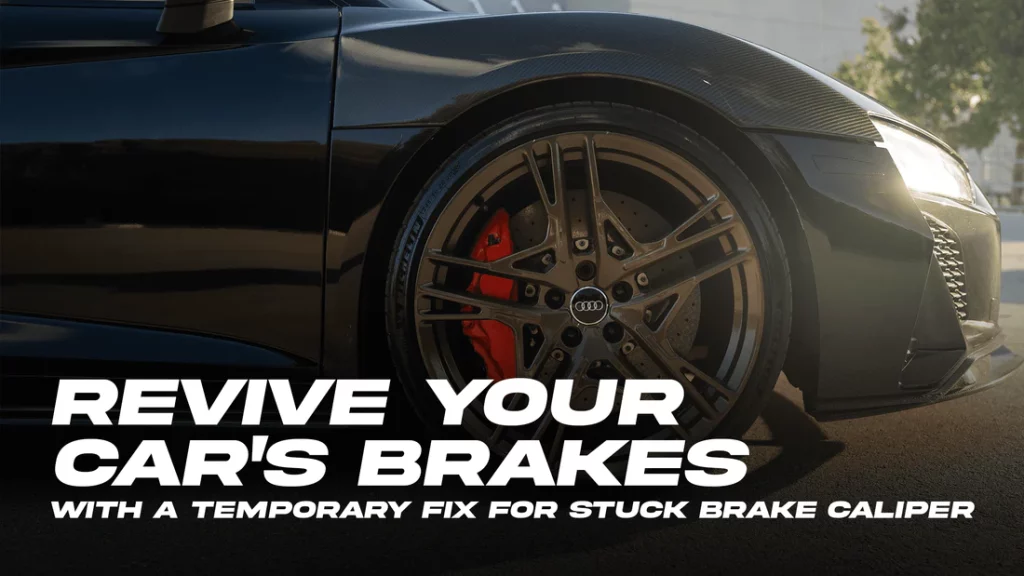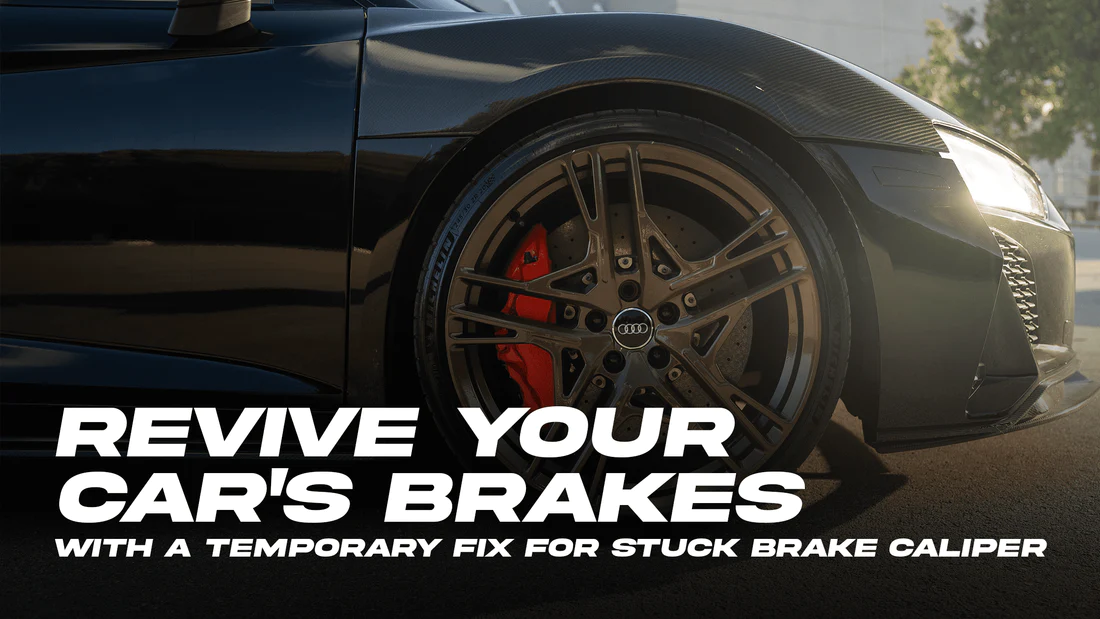
Lorem ipsum dolor sit amet, consectetur adipiscing elit. Ut elit tellus, luctus nec ullamcorper mattis, pulvinar dapibus leo.
Are you struggling with a stuck brake caliper in your dream car? Driving with faulty brakes is not only dangerous but can also lead to costly repairs. It is essential to maintain the brakes in your car regularly. However, sometimes things can go wrong, and you may find yourself with a stuck brake caliper. This issue can be tricky and may require an experienced mechanic to fix it. But did you know that there is also a temporary fix for stuck brake caliper that you can do at home? In this blog post, we will provide you with a step-by-step guide on how to revive your dream car’s brakes with a temporary fix for a stuck brake caliper. So, let’s get started!
What is a Stuck Brake Caliper?
A brake caliper is an essential component of the hydraulic braking system in a vehicle that applies pressure on the brake pads when you use the brake pedal. However, sometimes the caliper can get stuck or seized, causing the brake pads to stay in contact with the rotor. This issue is known as a stuck brake caliper, and it can be dangerous if left unaddressed.
Signs and Symptoms of a Stuck Brake Caliper
There are several signs that indicate that you may have a stuck brake caliper in your vehicle. Some of these include:
- Steering Issues: If you notice that your vehicle is pulling to one side when you apply the brakes, it may be due to a stuck brake caliper.
- Uneven Pads: When the brake caliper is stuck, it can cause uneven wear on the brake pads.
- High-Pitched Squeals: A stuck brake caliper can cause the brake pads to rub against the rotor, producing a high-pitched noise.
- Fluid on the Floor: A leaking brake caliper can cause brake fluid to leak onto the ground.
- Brake Pedal Stays Down: When the brake caliper is stuck, it can cause the brake pedal to stay down, making it difficult to stop the vehicle.
- Hard to Stop Vehicle: A stuck brake caliper can cause a significant decrease in stopping power.
- Burning Smell: If you smell something burning after applying the brakes, it may be due to a stuck brake caliper.
What Causes Brake Calipers to Stick?
There are several reasons why a brake caliper can get stuck or seized:
- The Caliper Slides: Over time, the caliper slides can become dirty or corroded, causing the caliper to stick.
- The Caliper Bolts: If the caliper bolts become loose or corroded, they can cause the caliper to stick.
- The Brake Hose: A kinked or clogged brake hose can cause the caliper to stick.
- Caliper Piston: If the caliper piston becomes corroded or damaged, it can cause the caliper to stick.
In the next section, we will discuss how to revive your dream car’s brakes with a temporary fix for a stuck brake caliper.
How to do Temporary Fix For Stuck Brake Caliper
If you’ve experienced a stuck brake caliper, you know how frustrating it can be. In addition to reduced performance and safety concerns, it can lead to unnecessary wear and tear on your vehicle’s braking system. But don’t worry, there’s a temporary fix for a stuck brake caliper that can help you revive your dream car’s brakes. In this guide, we will walk you through the tools and materials needed and the step-by-step process to get your vehicle back on the road as quickly as possible.
Tools and Materials Needed for a Temporary Fix of a Stuck Brake Caliper
Before getting started, you need to make sure you have the proper tools and materials on hand. Here’s a list of what you will need:
- Socket set
- Lug wrench
- Brake cleaner
- Brake lubricant
- C-clamp
Step-by-Step Guide for a Temporary Fix for Stuck Brake Caliper
Now that you have your tools and materials let’s dive into the step-by-step process to fix a stuck brake caliper.
- Identify the stuck brake caliper: The first step is to identify which brake caliper is stuck. If you’re not sure, pay attention to which wheel is overheating, smoking or has a burning smell after you’ve driven for a while.
- Check the affected wheel: Once you’ve identified the stuck brake caliper, check the affected wheel to see if it’s hot and if there’s any brake fluid leaking.
- Remove the wheel: Use your lug wrench to remove the wheel from the affected brake caliper.
- Inspect the brake caliper: With the wheel removed, inspect the brake caliper for any signs of damage or wear. Also, check the brake pads and ensure they are in good condition.
- Apply lubricant: Apply brake lubricant to the slide pins and the back of the brake pad. This will help loosen the caliper and ensure it moves smoothly.
- Compress the caliper piston: Using a C-clamp, compress the caliper piston until it is flush with the caliper. This will help free up the caliper and make it easier to move.
- Clean the brake system: Use brake cleaner to clean the rotor, caliper, and other brake components. This will help remove any grease, oil, or other contaminants that may be causing the brake caliper to stick.
- Replace the wheel: Once the brake system is clean, re-install the wheel and tighten the lug nuts.
- Test the brakes: Finally, take your vehicle for a test drive and test the brakes. Make sure they are functioning properly and that the affected wheel is no longer overheating or smoking.
By following these steps, you can temporarily fix a stuck brake caliper and get your vehicle back on the road in no time. Remember, this is only a temporary fix, and you should take your vehicle to a professional mechanic to diagnose and fix the root cause of the problem as soon as possible.
Temporary Fix for Stuck Brake Caliper – Fix by Symptoms
Knowing the symptoms of a stuck brake caliper is important in identifying the problem and fixing it temporarily to get you to a mechanic. Here are the top seven symptoms indicating that you have a stuck brake caliper problem in your vehicle.
#1: Issues with the Steering
If you feel that your vehicle is pulling to one side while driving, the problem could be with the brake caliper. A stuck caliper can cause uneven braking pressure and makes one brake rotor to engage more than the other, resulting in steering issues.
#2: Uneven Wear of Pads
Check the brake pads to identify if one brake pad is more worn out than the other. Uneven wear of brake pads is a common problem when you have a stuck brake caliper.
#3: Noises and High-Pitched Squeals
Ignoring the squeaky sound when you apply brakes can lead to dangerous situations. Pay close attention to high-pitched sounds that occur when you hit the brake pedal. These can be a sign of ineffective brake function, and the cause can be a sticky brake caliper.
#4: Leaking Fluid
Check the wheels for any signs of fluid spills or brake fluid leaks, as they can be a sign of a stuck brake caliper or other problems in the brake system. If you see brake fluid on the wheel, it could be a sign that the caliper piston is stuck and needs a temporary fix.
#5: Depressed Brake Pedal
If you have to depress your brake pedal more than usual, your caliper may be sticking, preventing the brake pads from being squeezed against the rotor as effectively. This can cause the pedal to sink before you hit the brakes finally.
#6: There Is a Hard Stop
When you’re driving, if you suddenly come to a hard stop or feel a sudden jolt, it could be due to a stuck brake caliper that’s not releasing evenly, causing one of the brake pads to grip the pad even when the brakes are not applied.
#7: A Burning Smell
If you smell something burning close to your wheel, it’s probably because of a stuck brake caliper. The brake caliper may be engaging with the rotor, causing them to overheat, hence the burning smell.
By looking for these symptoms, you can identify a stuck brake caliper and apply a temporary fix to get you to a mechanic for repairs. Remember, a temporary fix is just that – temporary. You should take your vehicle to a professional mechanic to diagnose and fix the root cause of the problem as soon as possible.
Precautions to Take while Driving with a Temporarily Fixed Stuck Brake Caliper
It’s important to recognize that a temporary fix for a stuck brake caliper is just that – a temporary fix. While this can help you get your vehicle safely to a mechanic, it’s vital to take some precautions while driving with a temporarily fixed stuck brake caliper to avoid any potential hazards. Here’s a list of precautions to take while driving with a temporarily fixed stuck brake caliper:
- Drive Slowly: It’s important to drive slowly and avoid sudden stops when you’re on the road with a temporarily fixed stuck brake caliper. You’ll need to give your vehicle ample time to stop if you need to pump the brakes.
- Use Both Feet: It is recommended to use both feet when driving with a temporarily fixed stuck brake caliper so you can apply both brakes evenly. While doing so, avoid applying too much pressure on the accelerator pedal.
- Pull Over if You Smell Burning: If you smell a burning odor or notice smoke coming from any brake assembly, pull over and stop driving immediately. This could be an indication that the brakes are overheating or catching fire.
- Avoid Driving Long Distances: Driving long distances with a stuck brake caliper can result in additional damage to the brake caliper, putting you and your car at risk. Avoid going on long trips, and try to get your vehicle to a mechanic as soon as possible.
- Check the Brakes Often: Check the brakes and wheels often, especially after any sudden stops, to help ensure that everything is running smoothly. Also, do not forget to check the brake fluid level from time to time.
By taking these precautions, you can minimize the risks associated with driving with a temporarily fixed stuck brake caliper, ensuring your safety and that of others on the road. Remember that a temporary fix is designed only to get you to a mechanic, so it’s important to have the issue resolved by a professional as soon as possible.
When to Seek Professional Help for a Stuck Brake Caliper?
While a temporary fix for a stuck brake caliper can save you time and money, it’s essential to know when it’s time to seek professional help. Ignoring the problem can lead to more significant issues, putting you and your vehicle at risk. Here are some signs and symptoms that indicate a need for professional repair or replacement of your stuck brake caliper:
In summary, if you notice any of the above signs or symptoms in your vehicle, it’s essential to seek professional help from a mechanic. Remember, a temporary fix is only temporary and will not solve the underlying problem, so don’t hesitate to get your vehicle inspected by a professional to ensure your brakes are in excellent working condition.
- If the brake caliper is beyond repair or if the damage is extensive, it may need to be replaced.
- If the brake pads are worn out on one side more than the other, it can indicate a more significant problem with the brake caliper.
- If the brake pedal is not as firm as usual, it can be a sign of a brake system issue.
- If you notice any strange noises when applying the brakes, this could indicate a more significant issue with the brake system.
- If you smell a burning odor coming from the brakes, it’s important to seek professional help immediately.
- Ignoring the problem of a stuck brake caliper can have severe consequences. If left untreated, it can cause the brake pads to wear out faster, cause uneven braking, and eventually lead to a risk of brake failure. It is also likely to cause damage to the brake disc or rotor, which will lead to reduced braking performance, increased stopping distance, and brake judder (vibration).
Preventing Future Stuck Brake Caliper Issues
While a temporary fix for a stuck brake caliper can save you time and money in the short term, it’s better to prevent the issue from happening in the first place. Here are some maintenance tips to help prevent stuck brake caliper issues:
- Regular Maintenance: Regular maintenance of your brakes is important to prevent issues such as stuck brake calipers. It is recommended to have your brake system inspected by a professional mechanic once a year or after every 12,000 miles.
- Use High-Quality Brakes: Using high-quality brake components can help prevent stuck brake calipers. Cheap brake components wear out faster and are more prone to sticking.
- Avoid Overheating: Overheating of the brakes can cause the brake pads to bind to the calipers or brake rotors, causing them to stick. Avoid riding the brakes or heavy braking, which can cause overheating.
- Clean Your Brakes: Brake components can collect dust, dirt, and other debris, causing unnecessary wear and tear. Regularly cleaning your brake components can help prevent issues such as stuck brake calipers.
- Inspect Your Brakes: Regularly inspecting your brake system can help identify potential issues before they cause major problems. Look for any signs of uneven wear on your brake pads or any leaks. Stay alert for any strange noises or feelings that occur while braking.
So, how often should you check your brake calipers? It is recommended to have your brake calipers checked whenever your brake system is inspected by a mechanic – at least once every year or every 12,000 miles. It’s essential to look for signs of damage to brake pads that can lead to stuck brake calipers. Here are some signs of damaged brake pads to look out for:
- Uneven wear on the brake pads
- Extremely worn brake pads
- Metal-to-metal contact between the brake pads and the rotor
- Cracked or distorted brake pads
By following these maintenance tips, you can prevent stuck brake caliper issues, avoid costly repairs, and ensure your vehicle’s brakes perform reliably and safely.
Stuck Brake Caliper – FAQs:
Stuck brake calipers are a common issue for car owners, and can be quite expensive to repair. In this section, we’ll answer some of the most frequently asked questions about stuck brake calipers, so you can get an idea of what causes them and how to handle them:
Yes, depending on the cause of the issue, a stuck brake caliper can sometimes unstick itself. However, it is best to have it inspected by a professional mechanic as soon as possible.
It is not recommended to drive with a stuck brake caliper since it can cause damage to other components of the brake system and compromise safety.
Revive Your Dream Car’s Look with Services from TPT Foreigns in Miami
Now that you understand everything about the temporary fix for a stuck brake caliper, you may also consider giving your car a refreshing new look. Get the luxurious look you’ve been dreaming of with the help of TPT Foreigns! With our custom brake caliper painting, powder coating and wrapping services, you can give your car the makeover it deserves. Plus, we offer unbeatable prices while ensuring a high-quality service. Don’t wait any longer – revamp your car’s look with the help of TPT Foreigns! Contact us today for more information.
Bottom Line
A temporary fix for stuck brake caliper can save you time and money in the short term, but it is important to recognize when it’s time to seek professional help. Ignoring the problem can lead to more significant issues, such as brake failure or reduced braking performance, putting you and your vehicle at risk.
It is also important to follow regular maintenance tips and inspect your brakes regularly to prevent stuck brake caliper issues. Proper care of your brakes will ensure they perform reliably and safely, so you can enjoy your dream car for years to come.

